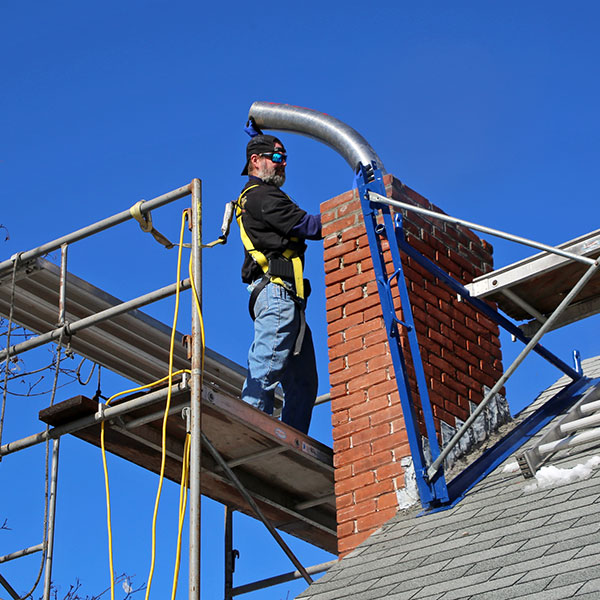Is it Time to Replace Your Chimney Liner?
At Above & Beyond Chimney Service, we’re a family-owned and operated company with over 25 years of industry experience, serving homeowners throughout Southern Massachusetts with the very best chimney and fireplace care. Our technicians have extensive training and experience, and we’re committed to providing you with the most durable, longest-lasting products and installations guaranteed.
 What’s the Purpose of a Chimney Liner?
What’s the Purpose of a Chimney Liner?
You may not realize it, but your fireplace and chimney are complex, and every component must work together efficiently to provide you with safe, comfortable heat.
When one of these components breaks down or suffers damage, it affects the entire system, including your chimney liner.
Several Functions of Chimney Liners
Shields Combustible Materials
The chimney liner acts as a shield to protect combustible materials like woodwork catching fire from errant sparks or extreme temperatures.
Protecting The Masonry
The chimney liner protects masonry from degrading due to gases and fumes coming from the fireplace.
Maintaining Proper Airflow
The chimney liner keeps the entire system running efficiently by maintaining proper airflow and preventing back puffing and creosote buildup.
Age and other factors cause your chimney liner to wear down, and if left alone, you could end up needing expensive repairs or worse.
So, let’s look at how to know when it’s time to replace your chimney liner.
How Do I Know When My Chimney Liner Needs Replacing?
As with all chimney and fireplace-related issues, the best way to know when something needs repairing or replacing is by calling a certified chimney service like Above & Beyond Chimney Service for an inspection.
Beyond that, here are five signs that it’s time to replace your chimney liner.
There Are Visible Signs of Damage or Deterioration
Age and wear & tear can cause cracks and other damage to your chimney liner, which presents risks of carbon monoxide poisoning, sparks, structural damage, and fire.
Your Chimney Experiences Condensation
Low temperatures and poor airflow cause condensation, and if the situation persists, it can lead to deterioration, inefficient fires, and increased creosote buildup.
You Notice Foul Odors Coming From the Fireplace
If you have moisture in the chimney because of a cracked chimney liner, you may end up with a musty odor coming from your fireplace.
You’ve Converted Your Fireplace to Burn Different Fuel
If you’ve converted your fireplace from wood to gas or vice versa, you must replace the chimney liner because the venting requirements are usually different, and the new liner must be able to handle the change.
There Are Pieces of Tile on the Firebox Floor
Once your chimney liner reaches an advanced state of deterioration, the flue liner’s clay tiles will fall off and onto the firebox’s floor.
Anytime your fireplace or chimney does something out of the ordinary, the safest thing to do is call one of our trained technicians at Above & Beyond Chimney Service for an inspection.
How Long Does a Chimney Liner Last?
While it’s true that wear and tear take their toll on a chimney liner, requiring its eventual replacement, the good news is that the average lifespan for a liner is between 15 and 20 years.
Of course, many factors play a role in your chimney liner’s longevity, including what the chimney liner is made from and how often you schedule chimney maintenance.
Clay tile liners are the most common liners because they’re inexpensive to install and readily available. However, some issues come with installing these liners, including how they absorb and distribute heat. Also, clay liners have a shorter lifespan than other types and typically need replacing after about 12 years.
Metal chimney liners, either stainless steel or aluminum, are superior to clay because they’re lighter, safer, and durable. A typical metal chimney liner can last up to 25 years with routine care.
The most expensive and challenging to install chimney liner is the cast-in-place liner, which is typically constructed out of cement. However, cast-in-place liners improve the chimney’s structural integrity and can last up to 50 years, so you have to weigh the installation price versus the longer lifespan.
The takeaway here is that regardless of the material, you can get the best performance from your chimney liner with routine chimney sweeping and maintenance, which is a nice segue to our next question.
 How Often Should I Have My Chimney Liner Inspected?
How Often Should I Have My Chimney Liner Inspected?
Many people don’t consider their fireplace/chimney a machine, but that’s what it is ––a simple machine. And like all machines, this one needs routine chimney inspections and maintenance to keep it running safely and efficiently each winter.
So, how often should you have your chimney liner inspected and cleaned?
Most experts agree that annual inspection and cleaning is the minimum to ensure your fireplace and chimney are safe and provide you with the comfort you want.
This is good advice, even if you don’t use your fireplace often, as rodents and other pests can set up homes in your chimney.
However, if you ever experience performance issues with your chimney, don’t wait for your annual cleaning; call a professional chimney sweep as soon as possible.
Call the Experienced Professionals at Above & Beyond Chimney Service
At Above & Beyond Chimney Service, we’re a family-owned and operated company with over 25 years of experience and dedicated service to homeowners throughout Southern Massachusetts. We’re committed to providing you with safe, effective chimney repair and maintenance with honesty and integrity.
Please check out our references and reviews, then call us to book an appointment.
Above & Beyond Chimney Service is located on Doane Street, Cohasset, MA.
Contact us by phone at (781) 383-0415 or online at https://aboveandbeyondchimneyservice.com.
